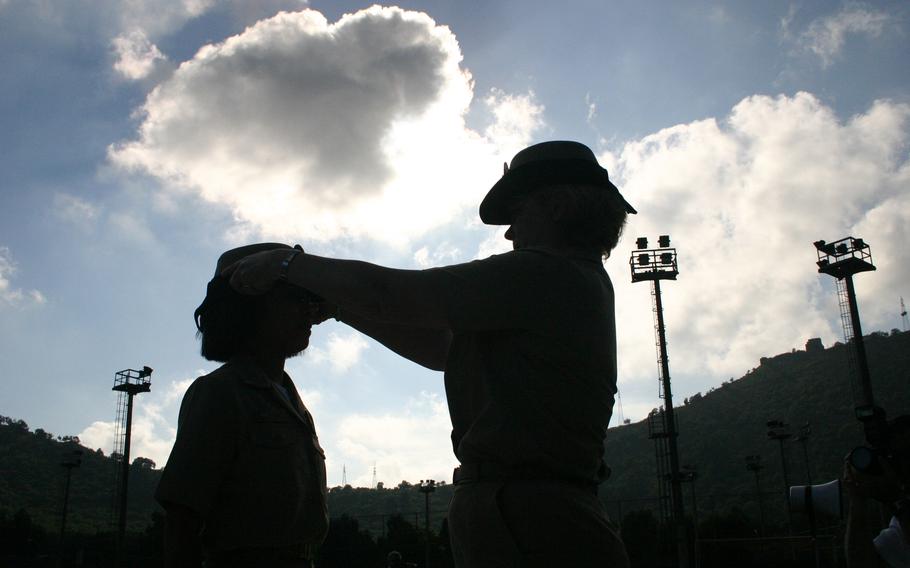
Chief Petty Officer Lisa Lazo, 32, stands tall as a sponsor places her new chief’s cover atop her head during Friday’s pinning ceremony, held at Carney Park in Naples, Italy. (Sandra Jontz/Stars and Stripes)
EDITOR’S NOTE: Each August, thousands of E-6s in the Navy go through a rigorous indoctrination before becoming senior noncommissioned officers. Stars and Stripes followed 21 sailors from Italy and Turkey who went through the six-week program in Naples, Italy. This is the third of a three-part series: Part I appeared Aug. 14 and Part II appeared Aug. 28.
NAPLES, Italy — Esequiel Sanchez just buried a dear, old friend.
Himself. A younger self. The one who joined the U.S. Navy 17 years ago, and up until Friday had worn the characteristic white Cracker Jack hat that is symbolic of enlisted Navy personnel.
But in a somber, private ceremony on the eve of the day he crossed into the world of being a chief petty officer, he literally buried that hat — and symbolically bid adieu to a former life.
“I got choked up when I said goodbye, but I said to the white hat that it would always be a part of me, regardless,” Sanchez said Friday after being pinned with the coveted golden chief’s anchors.
Now, he’s the go-to man, the one junior enlisted and officers alike will be coming to for answers. When they say “ask the chief,” he’ll be the one to respond.
Sanchez is among the 5,282 Navy E-6s out of an eligible pool of 19,646 worldwide selected to become senior enlisted noncommissioned officers. All are pinned on the same day.
New Chief Petty Officer C.J. Yoakum says that for the first time in more than 13 years, she can put to rest her competitiveness.
“It’s not about me anymore,” the ecstatic 44-year-old cryptologic technician said after Friday’s ceremony.
“I don’t have to compete with anyone anymore to get here. I am here. Now I can just teach, and teaching is what I do best.”
The Navy does not collect statistics on education level, skill area, languages, combat experience, etc., for the selectees because of the variables involved in the selection process, said Lt. Sarah Self-Kyler, a spokeswoman for the Navy Personnel Command in Washington.
But of the demographic information collected, nearly 28 percent of this year’s selectees are minorities, up from nearly 21 percent last year, and nearly 24 percent are female, up from nearly 19 percent last year.
“Those we selected for chief petty officer were selected because they are well-trained, motivated, sustained superior performers and proven leaders,” Self-Kyler said.
“The experience of these sailors, their level of education, their skill areas, while important, are considered indicators of their potential for leadership as a chief. The deciding factor — can we see this sailor, based on the evidence of leadership and superior performance, performing up to the high expectations as a chief?”
On Friday, the selectees wrapped up six grueling weeks of the “transition process,” no longer called “initiation.” Gone are the days of having sailors eat phallic-shaped bread, wear diapers, drink copious amounts of alcohol or swallow raw eggs dropped from a 6-foot ladder.
Still, it was six weeks of what some selectees called “humbling.”
They performed physical training in the pre-dawn hours, were tested on their knowledge of Navy history and challenged on obstacle courses to assess their physical readiness, ability to think out of the box and work as a team.
On Friday, they went through “battle stations” intentionally designed for failure if they failed to ask for help, said Master Chief Anthony Evangelista, fleet master chief for U.S. Naval Forces Europe/6th Fleet.
So as to not spoil the scenarios for future selectees, the chief community declined to talk details about the stations or to allow anyone outside of the Navy community to attend the training sessions.
Big changes are coming next year for the chiefs. On the April 1 birthday of the rank, Evangelista will unveil details for the Navy’s first CPO academies for Europe-based sailors, he said.
The academy will allow selectees to devote 100 percent concentration on the transition to becoming a chief, Evangelista said. Now, they divide their time between their current jobs and prepping to become chiefs.